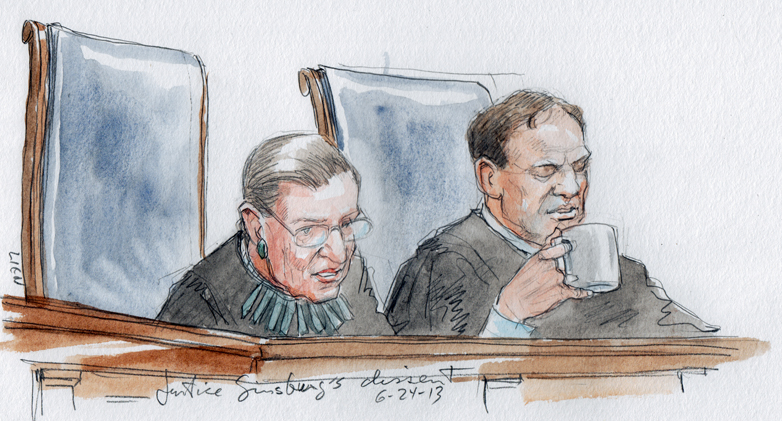There are some things that fail to register in transcripts of oral arguments at the Supreme Court. Such as contempt. When I sat in on the Abigail Fisher v. University of Texas at Austin arguments last October, I was impressed with Justice Antonin Scalia’s contempt for the attorneys defending the university’s modest affirmative-action program.
Reading the transcript eight months later, as the Court prepared to hand down a decision that will redefine the role of race in college admissions not only for the University of Texas but for all of the nation’s universities, I realized that Scalia’s contempt comes across remarkably well on paper. Consider:
Since we’re asking questions about just curiosity, I am curious to know how many. This is a very ambitious racial program here at the University of Texas. How many people are in the affirmative action department of the University of Texas? Do you have any idea? I mean, there must be a lot of people to monitor all these classes and do all of this assessment of race throughout the thing. There would be a lot of people out of a job, wouldn’t we, wouldn’t they, if we suddenly went to just 10 percent.
In six sentences, Scalia—who does most of the thinking for the Court’s dominant extreme-right block—managed to turn the university’s attempt to create a diverse student body into a make-work program for affirmative-action hustlers.
Scalia had already ridiculed the idea of diversity:
I’m asking you how. How? Did they look in the classroom? On their way in did they require everybody to check a box or they have somebody figure out, oh, this person looks 1/32nd Hispanic, and that’s enough?
Neither assertion is true. Consider the “ambitious racial program” Scalia described.
| Here are the facts behind what Justice Antonin Scalia called a University of Texas’ “ambitious racial program.” |
It increased African-American enrollment at UT Austin from 3 percent in 2002—after a Fifth Circuit Court of Appeals ruling in 1996 banned any consideration of race in the admissions process in Texas—to 6 percent in 2011, after an Supreme Court decision in 2003 provided admissions officers across the country with limited discretion in admitting minority students.
Justices Scalia, Samuel Alito, Clarence Thomas and Chief Justice John Roberts are determined to do away with that limited discretion. And they have no intention of letting the facts get in their way.
As the Court prepares to hand down its decision (which it had not done as we went to press), it is worthwhile to consider the facts that lie behind the lawsuit Fisher filed when in 2008 she claimed that her rightful place at the University of Texas at Austin was occupied by a less-qualified black kid.
In the early 1990s, the university was making gradual progress enrolling minority students.
Then in 1994, Cheryl Hopwood sued, claiming that what should have been her place in a first-year class at the University of Texas Law School was occupied by a minority student admitted on racial preferences.
Hopwood’s case got as far as the Fifth Circuit, which in 1996 prohibited all universities in the Fifth Circuit from considering race in the admissions process. African-American enrollment at UT Austin subsequently fell from 5 to 3 percent.
In 1998, the Texas Legislature created a “Top 10 Percent Rule” that provided automatic admission to the university for all students graduating in the top 10 percent of their class (which, of course, provides automatic admission for 10 percent of students graduating from the state’s many all-black high schools).
In 2003, the Supreme Court ruled that race and ethnicity can be considered in admissions—as long as the goal was to create a “critical mass of minority students” in institutions of higher learning.
By applying Legislature’s Top 10 Percent Rule and the discretion the Supreme Court allowed in 2003, admissions officials pushed African-American enrollment UT Austin up to 6 percent in 2011.
The “ambitious racial program” that troubles Justice Scalia resulted in African-American enrollment of 6 percent in a state where the black population is 12 percent. To quote Justice Scalia: “There are facts, and there are facts, aren’t they?”
Here’s one more.
Based on her high school grades and SAT scores, Fisher would not have been admitted to the 2008 fall class UT Austin—regardless of her race.
Justice Scalia could have found that fact on page 415 of an index prepared by attorneys representing the university.
And 168 black or Hispanic students with grades better than Fisher’s were denied admission to UT Austin in 2008.
Lou Dubose is the editor of The Washington Spectator.



